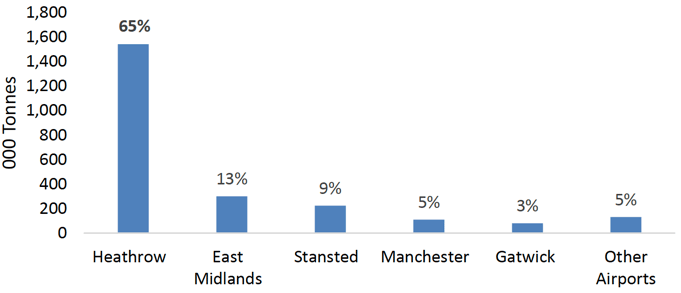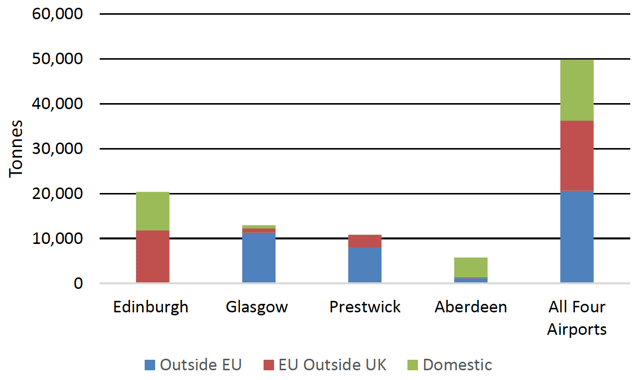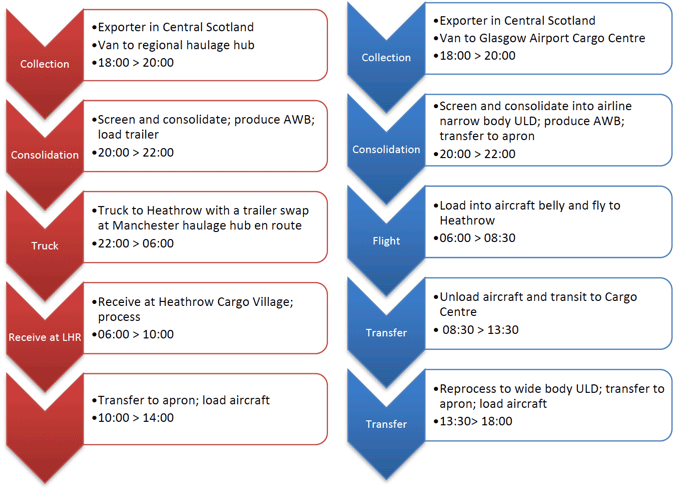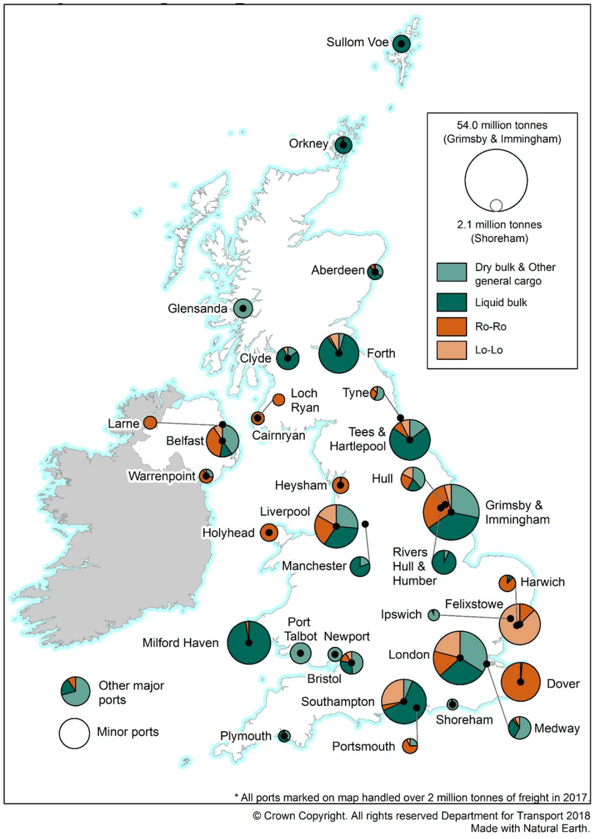Food and drink supply chain and transport industry: evidence report
Result of a study investigating existing Scottish food and drink export logistics, and their resilience.
4. Current capacity to export from Scotland
4.1 Aviation
According to the Freight Transport Association (FTA), airfreight accounts for approximately 40% of the total value of Britain's trade with countries outside the eurozone but only 0.5% of the volume of freight moved. The high value, low volume freight is transported in a range of ways within the UK and exported out of it.
This section summarises how airfreight operates in the UK with freight forwarders and integrators, the main airports and capacity and facilities at Scotland's airports.
4.1.1 UK Airfreight
In 2016, around 2.4 million tonnes of airfreight was moved through UK airports with the vast majority (80%) on flights to/from countries outside the EU. Airfreight to/from countries outside the EU is dominated by bellyhold cargo on scheduled passenger services. These flights account for 85% of total airfreight volumes. In contrast, short-haul markets are largely served by cargo planes.[47]
The figure below shows that five airports, and Heathrow in particular, dominate freight volumes at UK airports. The five (none of which are in Scotland) account for almost all (95%) of UK air freight traffic, with Heathrow alone seeing two-thirds of the total. Thus, the volumes through Scottish airports are insignificant in UK terms.
Figure 4. Freight volumes at UK airports: 2016[48]

It is clear that freight continues to concentrate at a few airports where there are extensive freight handling facilities.
The characteristics of demand at the five leading UK airports are:
- Heathrow, Manchester and Gatwick: almost all freight is to/from non-EU countries and almost all of it uses scheduled passenger services.
- East Midlands: has the biggest volume of domestic freight of any UK airport. Almost all freight through the airport is on cargo planes, largely through integrator services (commonly known as parcel delivery companies).
- Stansted: most air freight is to/from countries outside the EU, and almost all air freight uses cargo aircraft.
As for supply, the introduction of long-haul services from secondary cities has accelerated with the expansion of the Middle Eastern hub carriers and new aircraft designs with large bellyhold capacities. It has been estimated that the belly capacity of Middle Eastern hub carriers flying into Europe equalled the capacity of more than 100 weekly Boeing 777 freighter flights. Some regional airports (e.g. Glasgow, Edinburgh, Newcastle) have seen air freight growth due to the introduction of local long-haul passenger services (e.g. Emirates and Qatar).
Fifteen per cent of volume handled at Heathrow is air to air transhipments, though only a small fraction of this is believed to be of domestic origin. The vast majority of UK regional freight flowing through Heathrow is trucked between the airport and its point of origin/destination. Heathrow is the centre of the air freight industry in the UK, not only in terms of volume, value and the range of destinations covered, but also in terms of handling and broking companies. Analysis of UK trade data by MAG Group suggests that 7% of the value of export freight handled at Heathrow originates in Scotland.
Airlines UK analysis identifies that seafood represents 11% of all UK airfreight exports. Prestwick Airport senior management noted that, because of its small packaging, seafood is ideally suited to bellyhold airfreight on scheduled flights. The benefit of using scheduled aircrafts is that there are frequent flights giving the ability to break the load into small consignments to multiple destinations. In contrast, a charter plane is often held until the charter is full, which can age early deliveries and potentially flood a destination with a specific product, which may impact on market price.
4.1.2 Scottish Context
The four main Scottish airports with relevance to freight are Edinburgh, Glasgow, Prestwick and Aberdeen. Across these, most freight is on flights to/from countries outside the EU, followed by flights to/from other EU countries and each airport plays a distinct role (2016 freight volumes).[49]
- Edinburgh (20,400 tonnes): almost wholly a mix of mainland EU and domestic freight on integrator flights but with a growing volume on scheduled flights to China.
- Glasgow (13,000 tonnes): almost 90% of freight is to/from outside the EU all of which is flown on scheduled passenger services and, particularly, appears on the twice-daily Emirates flights to/from Dubai.
- Prestwick (10,800 tonnes): three-quarters of freight is to/from outside the EU. Almost all freight through the airport uses cargo aircraft with a new twice weekly cargo flight recently secured for Prestwick.[50]
- Aberdeen (5,700 tonnes): more than 75% of freight is on domestic integrator services.
Figure 5. Freight volumes by flight origin/destination area (2016)[51]

Traffic across the four Scottish airports grew by around 11,000 tonnes (29%) between 2011 and 2016. However, this growth was not evenly spread and was largely driven by the more than five-fold increase at Glasgow. The growth of over 10,000 tonnes at Glasgow was almost all on non-EU scheduled passenger services.
Demand also grew, albeit much more modestly, at:
- Aberdeen: 8%, mostly on domestic integrator services.
- Edinburgh: 5%, with EU volumes doubling but mostly offset by a decline in domestic traffic.
In contrast, volumes at Prestwick fell by 9%.
However, the total volume of airfreight handled by these top four Scottish airports in 2016 amounted to only 4% of the volume passing through Heathrow.
But it appears that there is spare capacity for bellyhold cargo on long-distance routes from Scottish airports. As an example, Emirates estimates total daily freight capacity on their services to Dubai to be nearly 70 tonnes, so around 24,000 tonnes per annum (though this is relatively modest in comparison with total food exports; the total weight of exported salmon alone, to all markets, is around 72,000 tonnes per annum).[52]
With the demand surge from North America and Far East markets for seafood, Glasgow Airport is also utilised for fresh salmon and high valued shellfish exports[53]. The introduction of the Edinburgh to Beijing flight has also opened up a market to China for high value shellfish exports.
Amongst the Scottish airports, only Glasgow currently has any refrigerated storage capacity, limiting the potential for regular handling of perishable goods. Edinburgh are currently undertaking an internal review of freight as they recognise it is an important component in underpinning any new long-haul services.
To increase freight handling capacity at Scottish airports in the short-term, one stakeholder engaged in this research stated that charter aircraft could be used to clear backlogs of goods, and that temporary refrigeration units could be installed at airports to enable easier handling of perishable goods. It was noted that Scottish airports have a good track record of responding flexibly to short-term changes in demand, and that there is capacity for more flights from Scottish airports.
4.1.3 Freight Forwarders and Integrators
Freight forwarders (brokers between shippers and consignees and the airlines) will organise most airfreight consignments moving from the UK; the end customer is highly unlikely to organise the details of the transportation or to be involved in the detail of route planning.
The most notable feature of the UK air freight market is the huge importance of Heathrow and its surrounding freight facilities, with most forwarders having major consolidation centres near the airport. Heathrow Airport Limited state that there are approximately 450 freight forwarders located within five miles of the airport.[54] Very significant volumes of air freight are trucked to such facilities near Heathrow, processed and then trucked to another airport, either in the UK or in continental Europe, without ever flying in or out of Heathrow itself.
Historically, this concentration around Heathrow can be explained as a result of its significantly more extensive intercontinental passenger network compared to those of other UK airports. Although this remains the case, new intercontinental passenger connections at regional UK airports have increased possibilities for transporting long-haul freight as bellyhold cargo.
The vast majority of regional freight flowing through Heathrow is trucked to or from its point of origin or destination. Only 15% of freight by volume handled at Heathrow is transhipped between planes and an even smaller fraction is transferred from planes of a domestic origin to longer distance international flights. Dedicated freighter services to other parts of the UK only typically make financial sense for logistics companies when the market is focussed around those areas and there is little to no network transfer requirements. Prestwick has captured some of this market and there may be opportunities for other regional airports to also do so. An exception to this rule is fresh seafood from Scotland, a small proportion of which flies in the bellyhold of some Glasgow – Heathrow services.
Improved regional passenger airfreight services are unlikely to cause a step change in the way freight is routed to Heathrow because:
- The way Forwarders have developed and operate their businesses favours continuing use of road haulage for domestic movements;
- "Change of Gauge" (i.e. from narrow to wide-body containers, which can be required for freight to be transhipped between planes of different type) is unattractive and the handling time/costs make any benefits over trucking marginal particularly as trucking operates around-the-clock.
Seabury, in their study for the National Connectivity Task Force (NCTF), illustrated the challenge that domestic airfreight into Heathrow faces and highlights why the majority of Scottish goods exported by air from Heathrow are trucked to/from Scotland.[55] The illustration below shows relationship typical comparison for journeys to Heathrow from Glasgow, however, the balance is likely to shift in favour of domestic airfreight for longer distance trips, such as Inverness.
Figure 6. The UK Regions and Heathrow – Road vs Air – Timings

Integrators are global carriers that incorporate the whole transport process: they manage all means of transport and the customs, freight and mail traffic. The Global integrators of TNT, UPS, Fedex and DHL all have a presence in Scotland with concentrations at East Midlands (c.50%) and Stansted (c.25%) and only a small number of dedicated cargo freighter flights operating at Heathrow.
4.2 Ports and Shipping Services
Scottish food and drink exporters make use of maritime services. Containers are used to transport cargoes that are less time sensitive, and mostly on longer-distance export routes. Some of these containers leave directly from Scottish ports (Greenock and Grangemouth), but these ports do not have the capacity to cater for the super-sized containerships, so most of these will be transhipped at Rotterdam, Southampton, Liverpool, Felixstowe or other northern European ports onto large ships for the majority of the journey. Other containers may be taken directly by road to these ports, or make use of smaller English ports, such as Teesport, for movement to the transhipment hub, but containers are mostly transported by rail on daily services from Freightliner's Coatbridge terminal to the major ports such as Felixstowe, Southampton, London Gateway and Liverpool.[56] DB Rail also runs a 5-times a week rail service between Teesport and Mossend.[57]
The choice of departure and transhipment port is affected as much by which commercial carrier is moving the load as the origin or final destination of the product.
Much of the produce bound for continental Europe is carried on road vehicles, making use of RoRo[58] ferries (we include the Channel Tunnel within this classification for simplicity). Shorter crossings will typically be used by accompanied services (where the tractor unit and driver remains with the trailer), but trailers on longer-distance ferries are often transported unaccompanied (without the tractor unit).
Since the cessation of the Rosyth-Zeebrugge ferry service in 2018, there has been no direct RoRo connection to Scotland. With the exception, therefore, of the containers exported from Scottish ports (which is believed to be only a modest proportion of all food and drink exported from Scotland in containers) and some exports to Ireland leaving from Cairnryan, the Scottish food and drink industry is entirely dependent on English ports.
The products handled at the UK's principal ports are shown in the figure below:
Figure 7. UK ports by cargo 2017[59]

Export data for all freight shows that Scottish ports carried 42.5 million tonnes of export goods in 2016. Between 2006 and 2016 overall waterfreight volumes (internal and export movements) have fallen by 34% which represents a trend of decline across Scottish ports.[60]
4.2.1 Existing ports in Scotland
Scotland's main container port is Grangemouth, handling 236,000 TEUs[61] in 2017. Much of the containerised product exported is whisky and other drinks but exports also include shortbread, frozen fish and seed potatoes. The return loads contain maturation casks from Spain and the US, packaging and glass for whisky, household products, textiles and food raw materials. Many empty containers are also returned to feed the export market. Grangemouth has easy road and rail connections, but is some 50 miles from the open sea. The lock entrance means that larger ships cannot enter or leave the port at high tide, and limits the size of container ships to around 1,500 TEU (for comparison, the very largest ships have a capacity of over 19,000 TEU).[62]
Regular container services are also available from Greenock. This handled 88,000 TEU in 2017, with again the large majority of export containers reported by stakeholders engaged in this research to be carrying whisky with smaller quantities of potatoes and fish.
Aberdeen is currently building a new (south) port at Nigg Bay, which is due to open in 2020. The new south port will offer 1,400m of berthing quay for ships up to 300m length with a draft of up to 10m. This would provide for added capacity.
Due to the relatively small size of the ports, there are no direct connections for container traffic from Scotland to non-EU destinations: longer-distance traffic relies on transhipment to ocean-going vessels at Rotterdam, Liverpool, Felixstowe or elsewhere.
Apart from Grangemouth, Greenock and Aberdeen no other Scottish ports currently have the capability to handle container traffic. It is understood, however, that there is significant underutilised capacity for container handling at the existing container ports, though one stakeholder engaged in this review cautioned that it may be difficult to build demand for container traffic to a level where the business case for more container shipping capacity from Scotland would be proven.
RoRo facilities for large vessels are available in mainland Scotland at Cairnryan (currently in use for services to Northern Ireland), Aberdeen (the Northern Isles), and Rosyth (not in regular use since cessation of the Zeebrugge service).
Grangemouth is unsuitable for ferry services which typically only call at coastal ports and depend on rapid turnaround of just a few hours. Ferries also prefer to avoid ports with narrow lock entrances or tidal delay due to shallow entrance channels.
Rosyth has been used as a ferry port, however it suffers from the constraint of several hours steaming distance from/to the open sea. Whilst the DFDS Rosyth-Zeebrugge RoRo service was discontinued in 2018, the service latterly primarily carried containers; the lack of a daily service and relatively long transit time, plus the lack of accompanied trailer or refrigerated trailer capacity, made the service unattractive to other types of traffic. In 2015, 414 lorries passed through Rosyth port, in comparison with over four million which used the short crossings of Dover-Calais and the Channel Tunnel combined.[63]
The EU Interreg Foodport Study (2015) also found that most driver-accompanied freight on North Sea routes prefers a Dutch port rather than Zeebrugge in part due to faster access afforded to Germany and beyond. Arrival times of the ferry in Belgium, and the relatively (compared to that from Calais) long road journey to Boulogne, made the service unattractive for serving seafood export traffic.
Sailing times are lengthy for any potential ferry connection between Scotland and mainland Europe, with vessels able to make only one one-way journey per day, so a return journey every 48 hours. The experience from Rosyth-Zeebrugge showed that most customers preferred the greater speed or flexibility offered by longer road journeys and shorter crossings. As a comparison, the Port of Dover states that (between all operators) they offer an average of a sailing to France every 30 minutes. P&O, one of the operators on that route, operate up to 25 sailings per day with a fleet of six vessels, so each making a return journey every six hours on average. A vessel employed on the Dover-Calais route is therefore able to provide eight times the total vehicle carrying capacity than if used on Rosyth-Zeebrugge or other similar overnight service.
Many other Scottish ports offer dry bulk handling, but this is not demanded by the industry. Aberdeen harbour has RoRo facilities, but being further from the main exports markets of Europe and north of much of the production and storage facilities of most Scottish exports, does not appear to offer any benefit over services from Rosyth. Stranraer is only a little further from mainland Europe than Rosyth, an estimated sailing distance to Roscoff in France of 500nm, in comparison with 450nm from Rosyth to Zeebrugge, but journeys to Roscoff or other locations on the Brest peninsular are distant from the main markets of Europe, most of which are better served from the low countries ports.
Contact
Email: socialresearch@gov.scot
There is a problem
Thanks for your feedback